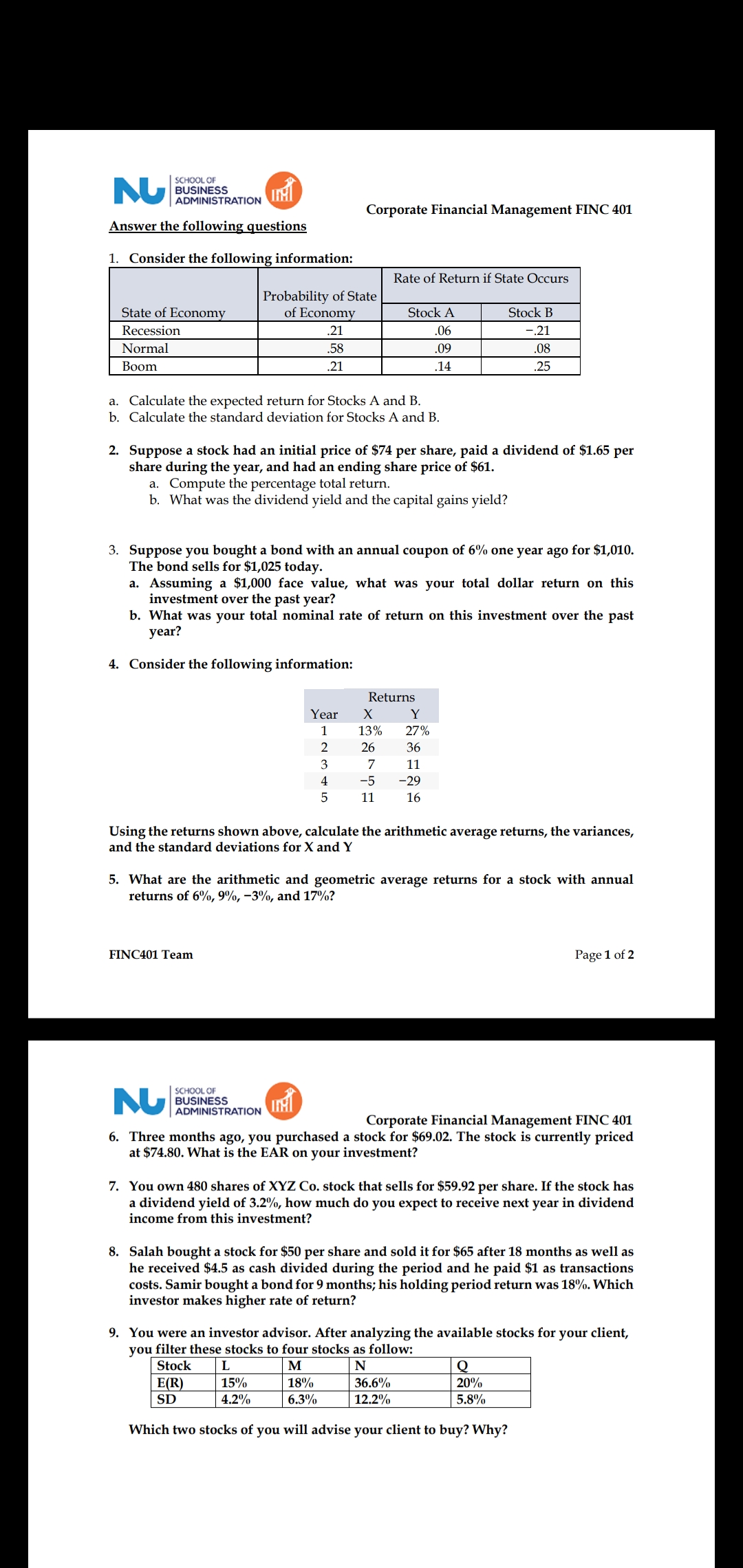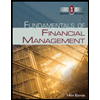SCHOOL OF BUSINESS ADMINISTRATION Corporate Financial Management FINC 401 Answer the following questions 1. Consider the following information: Rate of Return if State Occurs Probability of State of Economy State of Economy Stock A Stock B Recession .21 .06 -.21 Normal .58 .09 .08 Boom .21 .14 .25 a. Calculate the expected return for Stocks A and B. b. Calculate the standard deviation for Stocks A and B. 2. Suppose a stock had an initial price of $74 per share, paid a dividend of $1.65 per share during the year, and had an ending share price of $61. a. Compute the percentage total return. b. What was the dividend yield and the capital gains yield? 3. Suppose you bought a bond with an annual coupon of 6% one year ago for $1,010. The bond sells for $1,025 today. a. Assuming a $1,000 face value, what was your total dollar return on this investment over the past year? b. What was your total nominal rate of return on this investment over the past year? 4. Consider the following information: Returns Year Y 1 13% 27% 2 26 36 3 7 11 4 -5 -29 11 16 Using the returns shown above, calculate the arithmetic average returns, the variances, and the standard deviations for X and Y 5. What are the arithmetic and geometric average returns for a stock with annual returns of 6%, 9%, –3%, and 17%? FINC401 Team Page 1 of 2 SCHOOL OF BUSINESS ADMINISTRATION Corporate Financial Management FINC 401 6. Three months ago, you purchased a stock for $69.02. The stock is currently priced at $74.80. What is the EAR on your investment? 7. You own 480 shares of XYZ Co. stock that sells for $59.92 per share. If the stock has a dividend yield of 3.2%, how much do you expect to receive next year in dividend income from this investment? 8. Salah bought a stock for $50 per share and sold it for $65 after 18 months as well as he received $4.5 as cash divided during the period and he paid $1 as transactions costs. Samir bought a bond for 9 months; his holding period return was 18%. Which investor makes higher rate of return? 9. You were an investor advisor. After analyzing the available stocks for your client, you filter these stocks to four stocks as follow: Stock L Q 15% E(R) SD 18% 36.6% 20% 4.2% 6.3% 12.2% 5.8% Which two stocks of you will advise your client to buy? Why?
SCHOOL OF BUSINESS ADMINISTRATION Corporate Financial Management FINC 401 Answer the following questions 1. Consider the following information: Rate of Return if State Occurs Probability of State of Economy State of Economy Stock A Stock B Recession .21 .06 -.21 Normal .58 .09 .08 Boom .21 .14 .25 a. Calculate the expected return for Stocks A and B. b. Calculate the standard deviation for Stocks A and B. 2. Suppose a stock had an initial price of $74 per share, paid a dividend of $1.65 per share during the year, and had an ending share price of $61. a. Compute the percentage total return. b. What was the dividend yield and the capital gains yield? 3. Suppose you bought a bond with an annual coupon of 6% one year ago for $1,010. The bond sells for $1,025 today. a. Assuming a $1,000 face value, what was your total dollar return on this investment over the past year? b. What was your total nominal rate of return on this investment over the past year? 4. Consider the following information: Returns Year Y 1 13% 27% 2 26 36 3 7 11 4 -5 -29 11 16 Using the returns shown above, calculate the arithmetic average returns, the variances, and the standard deviations for X and Y 5. What are the arithmetic and geometric average returns for a stock with annual returns of 6%, 9%, –3%, and 17%? FINC401 Team Page 1 of 2 SCHOOL OF BUSINESS ADMINISTRATION Corporate Financial Management FINC 401 6. Three months ago, you purchased a stock for $69.02. The stock is currently priced at $74.80. What is the EAR on your investment? 7. You own 480 shares of XYZ Co. stock that sells for $59.92 per share. If the stock has a dividend yield of 3.2%, how much do you expect to receive next year in dividend income from this investment? 8. Salah bought a stock for $50 per share and sold it for $65 after 18 months as well as he received $4.5 as cash divided during the period and he paid $1 as transactions costs. Samir bought a bond for 9 months; his holding period return was 18%. Which investor makes higher rate of return? 9. You were an investor advisor. After analyzing the available stocks for your client, you filter these stocks to four stocks as follow: Stock L Q 15% E(R) SD 18% 36.6% 20% 4.2% 6.3% 12.2% 5.8% Which two stocks of you will advise your client to buy? Why?
Fundamentals of Financial Management (MindTap Course List)
14th Edition
ISBN:9781285867977
Author:Eugene F. Brigham, Joel F. Houston
Publisher:Eugene F. Brigham, Joel F. Houston
Chapter8: Risk And Rates Of Return
Section: Chapter Questions
Problem 7TCL
Related questions
Concept explainers
Risk and return
Before understanding the concept of Risk and Return in Financial Management, understanding the two-concept Risk and return individually is necessary.
Capital Asset Pricing Model
Capital asset pricing model, also known as CAPM, shows the relationship between the expected return of the investment and the market at risk. This concept is basically used particularly in the case of stocks or shares. It is also used across finance for pricing assets that have higher risk identity and for evaluating the expected returns for the assets given the risk of those assets and also the cost of capital.
Question

Transcribed Image Text:SCHOOL OF
BUSINESS
ADMINISTRATION
Corporate Financial Management FINC 401
Answer the following questions
1. Consider the following information:
Rate of Return if State Occurs
Probability of State
of Economy
State of Economy
Stock A
Stock B
Recession
.21
.06
-.21
Normal
.58
.09
.08
Вoom
.21
.14
.25
a. Calculate the expected return for Stocks A and B.
b. Calculate the standard deviation for Stocks A and B.
2. Suppose a stock had an initial price of $74 per share, paid a dividend of $1.65 per
share during the year, and had an ending share price of $61.
a. Compute the percentage total return.
b. What was the dividend yield and the capital gains yield?
3. Suppose you bought a bond with an annual coupon of 6% one year ago for $1,010.
The bond sells for $1,025 today.
a. Assuming a $1,000 face value, what was your total dollar return on this
investment over the past year?
b. What was your total nominal rate of return on this investment over the past
year?
4. Consider the following information:
Returns
Year
X
Y
1
13%
27%
26
36
3
7
11
4
-5
-29
11
16
Using the returns shown above, calculate the arithmetic average returns, the variances,
and the standard deviations for X and Y
5. What are the arithmetic and geometric average returns for a stock with annual
returns of 6%, 9%, -3%, and 17%?
FINC401 Team
Page 1 of 2
SCHOOL OF
BUSINESS
ADMINISTRATION
Corporate Financial Management FINC 401
6. Three months ago, you purchased a stock for $69.02. The stock is currently priced
at $74.80. What is the EAR on your investment?
7. You own 480 shares of XYZ Co. stock that sells for $59.92 per share. If the stock has
a dividend yield of 3.2%, how much do you expect to receive next year in dividend
income from this investment?
8. Salah bought a stock for $50 per share and sold it for $65 after 18 months as well as
he received $4.5 as cash divided during the period and he paid $1 as transactions
costs. Samir bought a bond for 9 months; his holding period return was 18%. Which
investor makes higher rate of return?
9. You were an investor advisor. After analyzing the available stocks for your client,
you filter these stocks to four stocks as follow:
Stock
M
Q
20%
5.8%
15%
E(R)
SD
18%
6.3%
36.6%
4.2%
12.2%
Which two stocks of you will advise your client to buy? Why?
Expert Solution
This question has been solved!
Explore an expertly crafted, step-by-step solution for a thorough understanding of key concepts.
This is a popular solution!
Trending now
This is a popular solution!
Step by step
Solved in 4 steps with 2 images

Knowledge Booster
Learn more about
Need a deep-dive on the concept behind this application? Look no further. Learn more about this topic, finance and related others by exploring similar questions and additional content below.Recommended textbooks for you

Fundamentals of Financial Management (MindTap Cou…
Finance
ISBN:
9781285867977
Author:
Eugene F. Brigham, Joel F. Houston
Publisher:
Cengage Learning

Essentials of Business Analytics (MindTap Course …
Statistics
ISBN:
9781305627734
Author:
Jeffrey D. Camm, James J. Cochran, Michael J. Fry, Jeffrey W. Ohlmann, David R. Anderson
Publisher:
Cengage Learning

Financial Reporting, Financial Statement Analysis…
Finance
ISBN:
9781285190907
Author:
James M. Wahlen, Stephen P. Baginski, Mark Bradshaw
Publisher:
Cengage Learning

Fundamentals of Financial Management (MindTap Cou…
Finance
ISBN:
9781285867977
Author:
Eugene F. Brigham, Joel F. Houston
Publisher:
Cengage Learning

Essentials of Business Analytics (MindTap Course …
Statistics
ISBN:
9781305627734
Author:
Jeffrey D. Camm, James J. Cochran, Michael J. Fry, Jeffrey W. Ohlmann, David R. Anderson
Publisher:
Cengage Learning

Financial Reporting, Financial Statement Analysis…
Finance
ISBN:
9781285190907
Author:
James M. Wahlen, Stephen P. Baginski, Mark Bradshaw
Publisher:
Cengage Learning